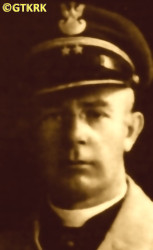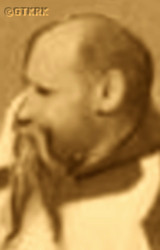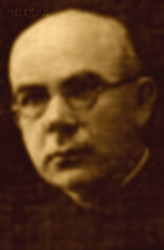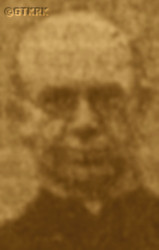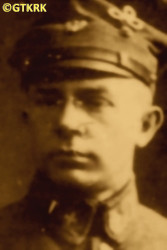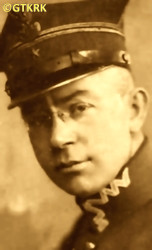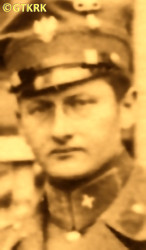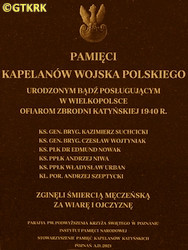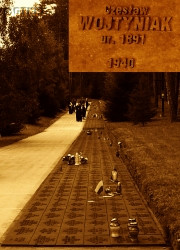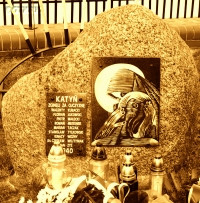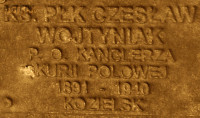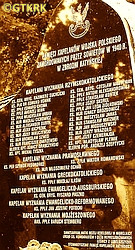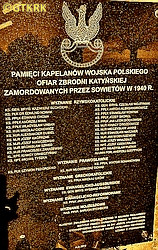Roman Catholic
St Sigismund parish
05-507 Słomczyn
85 Wiślana Str.
Konstancin deanery
Warsaw archdiocese, Poland
full list:
displayClick to display full list

searchClick to search full list by categories
wyświetlKliknij by wyświetlić pełną listę po polsku

szukajKliknij by przeszukać listę wg kategorii po polsku

Martyrology of the clergy — Poland
XX century (1914 – 1989)
personal data
surname
WOJTYNIAK
forename(s)
Ceslav (pl. Czesław)
function
diocesan priest
creed
Latin (Roman Catholic) Church RCmore on
en.wikipedia.org
[access: 2014.09.21]
diocese / province
Gniezno and Poznań archdiocese (aeque principaliter)more on
www.archpoznan.pl
[access: 2012.11.23]
RC Military Ordinariate of Polandmore on
en.wikipedia.org
[access: 2014.12.20]
honorary titles
„Pro Ecclesia et Pontifice”more on
„Pro Ecclesia et Pontifice”
War Order of Virtuti Militari — Silver (5th Class)more on
War Order of Virtuti Militari – Silver (5th Class)
(11.11.1976, Londontoday: London Cou., England, United Kingdom
more on
en.wikipedia.org
[access: 2024.03.19], decree of Stanislav Ostrowski, President of the Republic of Poland in exile)
September Campaign Crossmore on
September Campaign Cross
(01.01.1986, Londontoday: London Cou., England, United Kingdom
more on
en.wikipedia.org
[access: 2024.03.19], decision of George Premyslav Morawicz, Minister of Military Affairs of the Polish Government in exile)
„Medal of Independence”more on
„Medal of Independence”
(20.12.1932)
„Cross of Valour”more on
„Cross of Valour”
(c. 1921)
„Cross of Valour”more on
„Cross of Valour”
(c. 1920)
Commemorative Medal for War of 1918–21more on
Commemorative Medal for War of 1918-21
Ten Years of Independence Medalmore on
Ten Years of Independence Medal
„For Long Service” medal — bronzemore on
„For Long Service” medal – bronze
date and place
of death
04.1940

NKVD TverHQ at 17 4 Sovetskaya Str
today: Tver Medical Institute, Tver oblast, Russia
more on
en.wikipedia.org
[access: 2021.10.09]
alt. dates and places
of death
05.1940, 11.05.1940
details of death
In 1903, during the Prussian/German partition, while studying at the Germ. Königliches Auguste–Victoria–Gymnasium (Eng. Kaiser Augusta Wiktoria Gymnasium), a member of the Polish clandestine self‐educational Thomas Zan Society TTZ (in 1907, chairman of the school group). Later, during his seminar studies, cooperated with the legally published, but heavily censored, monthly magazine „Dawn. Polish Youth Magazine”, founded by members of TTZ, and in Gniezno became a member of the clandestine Polish Rifle Squad PDS, founded by TTZ and modeled on a similar organization operating legally in the Austrian‐occupied part of Poland.
During World War I, drafted in 1915 into the German Imperial Army — until 1918 was the chaplain of the Germ. Grenadier–Regiment König Wilhelm I Nr. 7 (Eng. 7th King William I Grenadier Regiment), whose home garrison was Legnica. The Regiment took part in battles on the Western Front.
After the abdication on 09.11.1918 of the German Emperor William II Hohenzollern; after the signing on 11.11.1918 by the Allies and the Germans, in the staff wagon in Compiègne, at the headquarters of French Marshal Ferdinand Foch, of the armistice and ceasefire — which de facto meant the end of World War I; and also after the handover on 11.11.1918 by the Regency Council – operating in the so‐called Germ. Königreich Polen (Eng. Polish Kingdom) occupied by the Central Powers (Germany and Austria–Hungary) — of supreme command over the army to Brigadier Joseph Piłsudski and his appointment as Commander‐in‐Chief of the Polish Army, which de facto meant the rebirth of the Polish state, encompassing however only the Germ. Königreich Polen, i.e. the Polish territory under Russian rule until 1915, but excluding the lands of the Prussian partition; Greater Poland — as the Prussian Germ. Provinz Posen (Eng. Poznań Province) — was still formally part of the German state. In Kościan, the seat of the Germ. Kreis Kosten (Eng. County Kościan), where was a vicar — his Grenadier Regiment returned to Legnica after the armistice in Compiègne, and was demobilized only on 19.12.1918 — both the Soldiers' and Workers' Council, consisting of representatives of the German army garrison stationed in Kościan and workers, both Polish and German, inspired by similar councils formed throughout Germany, and the Polish District People's Council PRL, founded at the appeal of the Supreme People's Council from Poznań, were established, as in other cities of Greater Poland. Cooperation between them was not easy, although it led to some successes of the Polish side. But the ambitions of the Polish side went further and when the Greater Poland Uprising broke out in Poznań on 27.12.1918, the garrison warehouses were taken over on 29‐30.12.1918 and the weapons were seized — which the Germans, upon hearing of the outbreak of the Uprising in Poznań, planned to transfer deep into Germany — by a group of Polish scouts, contrary to the decision of the PRL. This meant that till 06.01.1919, power in the city was basically taken over by the insurgents and Polish officials. On 07.01.1919, recruitment to the „1st Polish Battalion” was announced, successive companies of which were sent next to the south–western front of the Uprising, fighting alongside the „Leszno” Group. Became its chaplain and, among other things, created a first aid station in Górka Duchowna, c. 17 km from Kościan.
Then, on 29.01.1919, became a chaplain of the 1st Greater Poland Uhlan Regiment of the insurgent Greater Poland Army, formed two days earlier in Poznań — from 04.1919, its commander was Vladislav Anders. After the armistice in Trier on 16.02.1919, enforced by the victorious Entente countries, by virtue of which the Polish insurgent Greater Poland Army was recognized as an allied army and a border was set, which „German troops were forbidden to cross”, participated in reconnaissances of one of the squadrons of the Regiment on 05‐20.05.1919 near Wronki and on 28.06.1919 near Osiek nad Notecią, where took part in a bloody skirmish with the Germans. The latter happened on the very day when the Treaty of Versailles, ending World War I, was concluded, awarding Greater Poland to Poland.
01.08.1919 the Regiment set off for the Lithuanian–Belarusian front of the Polish–Russian War of 1919‐1921. By train it reached the Maladzyechna station and then marched to Radashkovichy, c. 35 km north of Minsk. As early as 08.08.1919 it fought a Russian armoured train and on 09.08.1919 entered Minsk, captured the day before. The application for the award of the Cross of Valour stated: „Took part […] in all actions, sorties and cavalry raids behind enemy lines […] In the action behind enemy lines during the offensive on Minsk […] during the battle was in the front line not only fulfilling his spiritual duties, but also serving as a role model and example with his personal courage”. From Minsk the Polish attack was directed south‐east, towards Babruysk. On 12.08.1919 it took part in the battles for Ihumen, and then on 28.08.1919 it entered Babruysk on the Berezina River. The Polish offensive of 06‐12.1919 led to the establishing of the front on the Berezina and Dvina rivers in the north, and a number of lakes connecting the upper Berezina with the Dvina — the line historically known as the Smolensk Gate. The Regiment defended the line of the Berezina River in the vicinity of Babruysk, taking part in several raids to the enemy's side. Was stationed on the Berezina throughout the winter of 1919‐1920.
In 12, 1919, became a chaplain — titular military priest — of the entire 1st Greater Poland Rifle Division, on 10.12.1919 rename as the 14th Greater Poland Infantry Division of the Polish Army, in which the 1st Uhlan Regiment fought at that time (in 01.1920, when the Treaty of Versailles came into force on 10.01.1920, after the ratifications, and Greater Poland formally became part of Poland, and its insurgent Army became part of the Polish Army, itself renamed the 15th Poznań Uhlan Regiment). In the spring of 1920, the Division defended the the lower Berezina line, down to the mouth to the Dnieper River. I.a. there, in the vicinity of Šacilki (today Svietlahorsk), on 09‐22.04.1920 took part in a series of skirmishes with the Russians. When the great Russian offensive of General Mikhail Tukhachevsky's group began on 04.07.1920, the Division, together with the entire Polish army, began retreat from the Berezina. In continuous battles with the Russians, it withdrew from Babruysk, through the Byaroza‐Kartuskaya, where on 21‐26.07.1920 it defended positions along the Yaselda River, Kobryn, Siedlce, to reach the Vistula line near Dęblin after almost 600 km of march. From there, during the decisive Battle of Warsaw (known as the „Miracle on the Vistula”), it attacked north, at the core of the so‐called counterattacks from the Wieprz River, which de facto split the advancing troops of General Tukhachevsky from their rear. On 21.08.1920 the Division captured Łomża, and on 26.08.1920 it did not allow Russian troops to retreat to the east, forcing them near Kolno to cross the border with German East Prussia, where they were interned. From there the Division was transferred to Brest on the Bug, where the Russians had already been pushed out. There, „fulfilling his priestly duties at the risk of his own life, spent most of his time on the battle line, morally encouraging the soldiers, which to a large extent contributed to many victories. On 12.09.1920 during the offensive near Brest‐Litovsk, stronger Bolshevik troops penetrated to our rear, dividing our group in the area east of Motykat […] Being at the northern group, wanting to get through to the southern group where his duties called him, ignored the great danger and broke through enemy areas, at the same time bringing back valuable information that was used for the further development of the action” (Ibid.) While pushing the Russians out, the Division fought, among others, on 15‐16.09.1920 north of Kobryn, near Byaroza, and then advancing towards Baranavichy. On 19‐20.09.1920 — during the second major battle of this war, the Battle of the Neman 20‐28.09.1920 — „near Pruzhany and Ruzhany […] was constantly in the firing line, proving great personal courage” (Ibid.) Driving the Russians out, the Division, after capturing Baranavichy, occupied Koydanava on 11.10.1920, c. 40 km from Minsk. On 15.10.1920 the Division entered Minsk, but left it the very next day — based on the signed armistice, Minsk was to remain on the Russian side.
Returned then to Greater Poland region, but immediately afterwards became the chaplain of the Plebiscite Defense Command DOP, established on 11.12.1920, headed by Colonel Paul Chrobok. The organization was the main command center of the Polish clandestine armed movement in Upper Silesia, dealing with the protection of Polish plebiscite rallies and outposts against German militants of the Germ. Kampforganisation Oberschlesien (Eng. Upper Silesian Combat Organization) and preparing for an armed uprising. The plebiscite, which was the result of the provisions of the Treaty of Versailles, marked by German terror, took place on 20.03.1921, but did not lead to any clear political decisions. Thus the 3rd Silesian Uprising broke out on 02.05.1921. Became the chaplain of the Supreme Command of the Insurgent Troops — i.e. former DOP — and the insurgents' units. The Uprising ended on 05.07.1921 and led to a more beneficial division of Upper Silesia for Poland.
In 1921‐1939 professional chaplain of the Polish Army.
After the German invasion of Poland on 01.09.1939 (the Russians attacked Poland 17 days later) and the beginning of World War II, supervised the evacuation of the Field Curia to the east starting on 04.09.1939.
After 17.09.1939, after the Russian attack, as captured by the Russians, prob. near Lutsk.
Held prob. in the NKVD PFL Frydrikhivka filtration camp, and then transported in cattle wagons to the NKVD PFL Kozelshchyna filtration camp near Poltava.
From there, on 04.11.1939, transported to the NKVD KLW Kozelsk concentration camp in Kozelsk.
On 23‐24.12.1939 prob. transported to Butyrki prison in Moscow, and then on 29.12.1939 to the KLW Ostashkov concentration camp in Ostashkov.
Finally taken to the execution site in Tver — NKVD deportation list, prob. No. 2, with an unknown date of preparation and with an order to hand over the POWs to the head of the NKVD Directorate in Tver, item 48 — and murdered.
In 08.1941, after the German attack on 22.06.1941 on their erswhile ally, the Russians, the field bishop of Polish troops in the West, Joseph Gawlina, appointed him — not knowing about his fate — the vicar general of the Polish Army being formed on the basis of Sikorski–Maysky Polish–Russian agreement of 30.07.1941.
By Polish Minister of Defence’s decision No. 439/MON of 05.10.2007 posthumously promoted to the rank of brigadier general.
cause of death
mass murder
perpetrators
Russians
sites and events
NKVD TverClick to display the description, «Katyn genocide 1940»Click to display the description, KLW OstashkovClick to display the description, Moscow (Butyrki)Click to display the description, KLW KozelskClick to display the description, PFL KozelshchynaClick to display the description, PFL FrydrikhivkaClick to display the description, Ribbentrop‐MolotovClick to display the description, Pius XI's encyclicalsClick to display the description, Silesian UprisingsClick to display the description, Polish‐Russian war of 1919‐1921Click to display the description, Polish‐Ukrainian war of 1918‐1919Click to display the description, Greater Poland UprisingClick to display the description, Thomas Zan SocietiesClick to display the description
date and place
of birth
19.07.1891Birth certification on:
photos.szukajwarchiwach.gov.pl
[access: 2025.08.19]

Puszczykowotoday: Puszczykowo urban gm., Poznań pov., Greater Poland voiv., Poland
more on
en.wikipedia.org
[access: 2021.07.25]
parents
WOJTYNIAK Valentine
🞲 12.02.1863, Borowotoday: Czempiń gm., Kościan pov., Greater Poland voiv., Poland
more on
en.wikipedia.org
[access: 2025.01.21] — 🕆 ?, ?

MOTYLAK Agnes
🞲 26.12.1860, Jarogniewicetoday: Czempiń gm., Kościan pov., Greater Poland voiv., Poland
more on
en.wikipedia.org
[access: 2021.12.18] — 🕆 ?, ?
presbyter (holy orders)
ordination
19.12.1914

Gnieznotoday: Gniezno urban gm., Gniezno pov., Greater Poland voiv., Poland
more on
en.wikipedia.org
[access: 2021.12.18]
Assumption of the Blessed Virgin Mary RC archcathedral churchmore on
en.wikipedia.org
[access: 2025.03.14]
positions held
1938 – 1939
vice–chancellor — Warsawtoday: Warsaw city pov., Masovia voiv., Poland
more on
en.wikipedia.org
[access: 2021.10.09] ⋄ Bishop's Curia of the Polish Military, Polish Armed Forces — also: in 1938 temporarily acting („ad interim”) chancellor, i.e. deputy of the military Bp Joseph Gawlina
1934 – 1938
RC military dean — Warsawtoday: Warsaw city pov., Masovia voiv., Poland
more on
en.wikipedia.org
[access: 2021.10.09] ⋄ Bishop's Curia of the Polish Military, Polish Armed Forces — head of a department; on 19.03.1937 appointed military dean of the Roman Catholic faith, with the rank of colonel; also: deputy judicial vicar at the Military Bishop's Court
03.10.1930 – 04.1934
RC military pastor — Brest on Bugform.: Brest‐Litovsk /till 1923/
today: Brest, Brest dist., Brest reg., Belarus
more on
en.wikipedia.org
[access: 2021.09.29] ⋄ Corps District OK No. IX Brest on Bug, Polish Armed Forces ⋄ St Casimir RC military parish — acting („ad interim”) dean
18.08.1929 – 03.10.1930
RC military pastor — Baranavichytoday: Baranavichy dist., Brest reg., Belarus
more on
en.wikipedia.org
[access: 2022.05.02] ⋄ „Navahrudak” Brigade No. 2, Border Security Corps KOP, Polish Armed Forces
1921 – 18.08.1929
RC military pastor — Poznańtoday: Poznań city pov., Greater Poland voiv., Poland
more on
en.wikipedia.org
[access: 2021.07.18] ⋄ Corps District OK No. VII Poznań, Polish Armed Forces ⋄ St Joseph Spouse of the Blessed Virgin Mary RC military parish — deputy head of the District's pastoral care; by decree of the Chief of State of 03.05.1922, confirmed with seniority from 01.06.1919 and 20th place on the list of Roman Catholic military pastors, in the rank of lieutenant colonel; by decree No. L. 3448 of the Commander‐in‐Chief of 16.12.1921, verified with seniority from 01.04.1920 and 20th place on the list of Roman Catholic military pastors, in the rank of lieutenant colonel; also: administrator of the military parish
c. 12.1920 – c. 05.07.1921
RC military chaplain — (Upper Silesia territory)today: Poland
more on
en.wikipedia.org
[access: 2023.11.24] ⋄ Supreme Command of the Insurgent Troops, Polish Armed Forces — till 02.05.1921 Plebiscite Defense Command
12.1919 – c. 12.1920
RC military chaplain — 14th Greater Poland Infantry Division, Polish Armed Forces — titular military pastor; formally accepted into the Polish Army as a Roman Catholic chaplain by L. 2238 decree of the Commander‐in‐Chief of 30.07.1920
07.01.1919 – 12.1919
RC military chaplain — Greater Poland Army (i.e. Polish Armed Forces in the former Prussian Partition), Polish Armed Forces — from 07.01.1919 of the 1st Polish Battalion from Kościan; from 29.01.1929 of the 1st Greater Poland Uhlan Regiment
1918 – 1919
vicar — Kościantoday: Kościan gm., Kościan pov., Greater Poland voiv., Poland
more on
en.wikipedia.org
[access: 2021.07.18] ⋄ Blessed Virgin Mary of the Assumption RC parish ⋄ Kościantoday: Kościan gm., Kościan pov., Greater Poland voiv., Poland
more on
en.wikipedia.org
[access: 2021.07.18] RC deanery
1915 – 1918
RC military chaplain — Germ. Grenadier–Regiment König Wilhelm I Nr. 7 (Eng. 7th King William I Grenadiers Regiment), German Imperial Army
1915
vicar — Kostrzyntoday: Kostrzyn gm., Poznań pov., Greater Poland voiv., Poland
more on
en.wikipedia.org
[access: 2021.12.19] ⋄ St Peter and St Paul the Apostles RC parish ⋄ Kostrzyntoday: Kostrzyn gm., Poznań pov., Greater Poland voiv., Poland
more on
en.wikipedia.org
[access: 2021.12.19] RC deanery
1915
vicar — Pniewytoday: Pniewy gm., Szamotuły pov., Greater Poland voiv., Poland
more on
en.wikipedia.org
[access: 2021.07.18] ⋄ St Lawrence the Martyr RC parish ⋄ Lwówektoday: Lwówek gm., Nowy Tomyśl pov., Greater Poland voiv., Poland
more on
en.wikipedia.org
[access: 2020.11.27] RC deanery
till 1914
student — Gnieznotoday: Gniezno urban gm., Gniezno pov., Greater Poland voiv., Poland
more on
en.wikipedia.org
[access: 2021.12.18] ⋄ philosophy and theology, Archbishop's Practical Theological Seminary (Lat. Seminarium Clericorum Practicum)
from 1910
student — Poznańtoday: Poznań city pov., Greater Poland voiv., Poland
more on
en.wikipedia.org
[access: 2021.07.18] ⋄ philosophy and theology, Archbishop's Theological Seminary (Collegium Leoninum)
others related
in death
DUBIELClick to display biography Alexander, JANASClick to display biography Mieczyslav, KACPRZAKClick to display biography Joseph, MARCOŃClick to display biography Mieczyslav, MASŁOŃClick to display biography Vladislav, MIKUCZEWSKIClick to display biography Joseph, MIODUSZEWSKIClick to display biography John, NOWAKClick to display biography Edmund, OCHABClick to display biography Vladimir, PASZKOClick to display biography Richard, ROMANOWSKIClick to display biography Victor, SKORELClick to display biography Joseph, SZWEDClick to display biography Bronislav, ZAKRZEWSKIClick to display biography Francis, DADACZYŃSKIClick to display biography Roman Joseph, GORGOLEWSKIClick to display biography Joseph, SMOLIŃSKIClick to display biography Joseph Tomislav Henry, TRZYBIŃSKIClick to display biography Valentine, WILKANSClick to display biography Julian, DRUŻBACKIClick to display biography Nicholas Felix John, POGŁÓDEKClick to display biography Constantine
sites and events
descriptions
NKVD Tver: On 04.04‐22.05.1940 the Russians executed in NKVD HQ building at 4 Sovetskaya Str (now Tver Medical Institute) in Tver c. 6,314 Polish prisoners of war (POW) kept in KLW Ostashkov concentration camp in Ostashkov. This genocide was the implementation of the decision of the Russian Commie‐Nazi authorities — the Politburo of the Russian Commie‐Nazi party — of 05.03.1940 to exterminate tens of thousands of Polish intelligentsia and servicemen, held in Russian camps established after the German‐Russian Ribbentrop‐Molotov Agreement and the annexation of half of Poland by the Russians in 1939, known as «Katyn genocide». After the formal „verdict”, the NKVD Special Council Moscow, i.e. the genocidal Russian kangaroo court known as the «NKVD Troika», sent successive disposition letters to the NKVD in Tver — there were c. 60 of them — containing the names of the persons to be murdered. The prisoners were brought — Tver is c. 190 km from Ostashkov — to the NKVD HQ building, identified one by one in a basement room known as the „Lenin’s room”, handcuffed, taken to another room cellar with a door covered with felt, and then murdered individually by a shot from a German Walther P38 pistol into the back of the head. The bodies where next dumped into mass graves in ditches in the Miednoje forest, in the NKVD summer resort, and covered with sand by an excavator. (more on: pl.wikipedia.orgClick to attempt to display webpage
[access: 2012.11.23], en.wikipedia.orgClick to attempt to display webpage
[access: 2014.05.09])
«Katyn genocide 1940»: 05.03.1940, the Russian Commie‐Nazi authorities — the Politburo of the Russian Commie‐Nazi party headed by Joseph Stalin — made a formal, secret decision No. P13/144 to exterminate tens of thousands of Polish intelligentsia and military personnel, „declared and hopeless enemies of the Russian government”, held in Russian camps, as a consequence of the German‐Russian Ribbentrop‐Molotov Agreement, the invasion of Poland and annexation of half of Poland in 09.1939, and the beginning of World War II. The decision was, as it were, „sanctioned” by the verdicts of the NKVD Special Council, i.e. the genocidal Russian kangaroo court known as «NKVD Troika» in Moscow. The implementation in Ukraine and Belarus was made possible by order No. 00350 of 22.03.1940 of the head of the NKVD, Lavrentiy Beria, on the „unloading of NKVD prisons”, i.e. transfer of prisoners from several prisons in Ukraine and Belarus to central prisons, e.g. in Kiev or Minsk. The genocidal «NKVD Troika», after issuing sentences, also sent to local NKVD units, NKVD disposition lists — i.e. lists of convicts — each containing on average c. 100 names. Named lists are known — may be reconstructed — for people held in the KLW Kozelsk and KLW Ostashkov camps, but not for KLW Starobilsk, known for victims from Ukrainian prisons, but not Belarusian ones. It is not even known exactly how many lists there were, mainly because the number of them sent to the NKVD in Belarus is unknown. On 03.03.1959 Alexander Shelepin, then head of the Russian KGB, in a handwritten note stated: „ Since 1940, the Committee for State Security under the Council of Ministers of Russia, has been keeping records and other materials relating to the prisoners of war and interned officers, gendarmes, policemen, etc., people from former bourgeois Poland shot that year. In total, based on the decision of the special troika of the NKVD of the USSR, 21,857 people were shot, of whom: 4,421 people in the Katyn Forest (Smolensk Oblast), 3,820 people from the Starobilsk camp near Kharkov, 6,311 people from the Ostashkov camp (Kalinin Oblast), and 7,305 people in other camps and prisons in Western Ukraine and Western Belarus. The entire operation of liquidation of the above–mentioned was carried out on the basis of the Resolution of the Central Committee of the CPSU of 05.03.1940”. The head of the NKVD recommended to the Russian leader, Nikita Khrushchev, to destroy all personal files of those shot in 1940, but to keep the minutes of the meetings of the «NKVD Troika» and confirmations of the implementation of the decisions of the «NKVD Troika». A one–sentence draft resolution was attached to the note. It is not known whether the resolution was accepted and whether the files were destroyed. The aforementioned protocols and confirmations of the «NKVD Troika» are also not known. There are indications — i.e. four so‐called „NKVD‐Gestapo Methodical Conferences” of 1939‐1940: in Brest on Bug, Przemyśl, Zakopane and Cracow — of close collaboration between Germans and Russians in realization of plans of total extermination of Polish nation, its elites in particular — decision that prob. was confirmed during meeting of socialist leaders of Germany: Mr Heinrich Himmler, and Russia: Mr Lavrentyi Beria, in another German leader, Mr Hermann Göring, hunting lodge in Rominty in Romincka Forest in East Prussia. (more on: en.wikipedia.orgClick to attempt to display webpage
[access: 2023.12.15])
KLW Ostashkov: Russian Rus. Концентрационный Лагерь для Военнопленных (Eng. POW Concentration Camp) KLW, run by genocidal Russian NKVD organization, for Poles arrested after the invasion in 1939, operating in 1939‐1940 in Ostashkov — in practice on Seliger lake Stolbnoy island and Svetlitsa peninsula, c. 11 km from Ostashkov, in a former Orthodox monastery, Niłowo‐Stołobieńska Hermitage, looted and shut down by Russian Bolsheviks in 1928. In 04.1940 6,570 were held captive there (in 11.1940 — 8397), out of which c. 6,300 were subsequently — as the fulfillment of Russian government decision to exterminate Polish intelligentsia and prisoners of war camps (Polish holocaust) — executed in Tver. Among the victims were officers of the Polish State Police, the Border Protection Corps KOP, Military Police, the Prison Service, officers and soldiers of the Polish Army, intelligence and counterintelligence officers of the Second Department of the General Staff, priests, employees of the judiciary, the fire brigade, foresters and military settlers from the eastern part of the Second Polish Republic. On another island of Lake Seliger, Gorodomla, in 1946‐1953 the Russians held a group of German specialists from Wernher von Braun's team, who, under the direction of Sergei Korolev, worked on Russian missiles. (more on: pl.wikipedia.orgClick to attempt to display webpage
[access: 2012.11.23])
Moscow (Butyrki): Harsh transit and interrogation prison in Moscow — for political prisoners — where Russians held and murdered thousands of Poles. Founded prob. in XVII century. In XIX century many Polish insurgents (Polish uprisings of 1831 and 1863) were held there. During Communist regime a place of internment for political prisoners prior to a transfer to Russian slave labour complex Gulag. During the Great Purge c. 20,000 inmates were held there at any time (c. 170 in every cell). Thousands were murdered. (more on: en.wikipedia.orgClick to attempt to display webpage
[access: 2020.05.01])
KLW Kozelsk: Russian Rus. Концентрационный Лагерь для Военнопленных (Eng. POW Concentration Camp) KLW, run by genocidal Russian NKVD organization, for Poles arrested after the invasion in 1939, operating in 1939‐1940 in Kozelsk — on the premises of the 18th century Orthodox Stauropygial Introduction of the Mother of God into the Temple Optyn Monastery, shut down and robbed by the Russian Bolsheviks in 1923. In 04‐05.1940, c. 4,594 people were detained there, who were then — as part of the implementation of the decision of the Russian authorities to exterminate dozens thousands of Polish intelligentsia and military personnel — murdered in Katyn. The prisoners included one rear admiral of the Polish Navy, four generals, c. 100 colonels and lieutenant colonels, c. 300 majors and c. 1,000 captains and captains of the Polish Army. Around half of them were reserve officers, including: 21 professors, associate professors and lecturers at universities, over 300 doctors, several hundred lawyers, several hundred engineers, several hundred teachers and many writers, journalists and publicists. There was also one woman, 2nd Leutenant pilot Janine Lewandowska. (more on: pl.wikipedia.orgClick to attempt to display webpage
[access: 2012.11.23])
PFL Kozelshchyna: Russian Rus. Проверочно‐Фильтрационный Ла́герь (Eng. Testing and Filtration Camp) PFL, where the genocidal Russian NKVD organization carried out selection and isolation of the most „dangerous” or most valuable prisoners — established after the Russian invasion of Poland on 17.09.1939, the establishment of the NKVD Board for Prisoners of War and Internees on 19.09.1939 by the head of the NKVD, Lavrenty Beria, and the order to establish a number of camps for Polish POWs. Set up c. 500 m from the Kozelshchyna railway station, in the Poltava Oblast in Ukraine, by the Poltava‐Kremenchuk railway line. In 1939, c. 8,000 Polish POWs were held captive prior to being transported to other concentration camps. Police prisoners were kept in tents, rank‐and‐file soldiers in the buildings of the former Orthodox monastery church, shut after the Bolsheviks took power in Russia, and officers were kept in the rest of the church buildings, converted by the Bolsheviks mainly into state farm pigsties (emptied after the pigs died out during the erysipelas epidemic). Everyone was forced to do slave work, according to the principle „those who don't work, don't eat”. According to the survivers, place was cold and they had to queue for hours for water. (more on: www.insignis.plClick to attempt to display webpage
[access: 2023.12.15])
PFL Frydrikhivka: Russian Rus. Проверочно‐Фильтрационный Ла́герь (Eng. Testing and Filtration Camp) PFL, where the genocidal Russian NKVD organization carried out selection and isolation of the most „dangerous” or most valuable prisoners — established after the Russian invasion of Poland on 17.09.1939, the establishment of the NKVD Board for Prisoners of War and Internees on 19.09.1939 by the head of the NKVD, Lavrenty Beria, and the order to establish a number of camps for Polish POWs. Operated from 20.09.1939 to 02.1940 in the village of Frydrikhivka on Zbruch river, near the Ternopil‐Khmelnytsky railway line. C. 5,000 soldiers of the Polish Army, mainly officers, were held there. The prisoners spent the night between farm stables, some in the barracks in nearby Volochysk, some in the open air, without any facilities, food was not distributed regularly. It was a transit camp from which POWs were sent to other camps. (more on: pl.wikipedia.orgClick to attempt to display webpage
[access: 2023.12.15])
Ribbentrop‐Molotov: Genocidal Russian‐German alliance pact between Russian leader Joseph Stalin and German leader Adolf Hitler signed on 23.08.1939 in Moscow by respective foreign ministers, Mr. Vyacheslav Molotov for Russia and Joachim von Ribbentrop for Germany. The pact sanctioned and was the direct cause of joint Russian and German invasion of Poland and the outbreak of the World War II in 09.1939. In a political sense, the pact was an attempt to restore the status quo ante before 1914, with one exception, namely the „commercial” exchange of the so‐called „Kingdom of Poland”, which in 1914 was part of the Russian Empire, fore Eastern Galicia (today's western Ukraine), in 1914 belonging to the Austro‐Hungarian Empire. Galicia, including Lviv, was to be taken over by the Russians, the „Kingdom of Poland” — under the name of the General Governorate — Germany. The resultant „war was one of the greatest calamities and dramas of humanity in history, for two atheistic and anti‐Christian ideologies — national and international socialism — rejected God and His fifth Decalogue commandment: Thou shall not kill!” (Abp Stanislav Gądecki, 01.09.2019). The decisions taken — backed up by the betrayal of the formal allies of Poland, France and Germany, which on 12.09.1939, at a joint conference in Abbeville, decided not to provide aid to attacked Poland and not to take military action against Germany (a clear breach of treaty obligations with Poland) — were on 28.09.1939 slightly altered and made more precise when a treaty on „German‐Russian boundaries and friendship” was agreed by the same murderous signatories. One of its findings was establishment of spheres of influence in Central and Eastern Europe and in consequence IV partition of Poland. In one of its secret annexes agreed, that: „the Signatories will not tolerate on its respective territories any Polish propaganda that affects the territory of the other Side. On their respective territories they will suppress all such propaganda and inform each other of the measures taken to accomplish it”. The agreements resulted in a series of meeting between two genocidal organization representing both sides — German Gestapo and Russian NKVD when coordination of efforts to exterminate Polish intelligentsia and Polish leading classes (in Germany called «Intelligenzaktion», in Russia took the form of Katyń massacres) where discussed. Resulted in deaths of hundreds of thousands of Polish intelligentsia, including thousands of priests presented here, and tens of millions of ordinary people,. The results of this Russian‐German pact lasted till 1989 and are still in evidence even today. (more on: en.wikipedia.orgClick to attempt to display webpage
[access: 2015.09.30])
Pius XI's encyclicals: Facing the creation of two totalitarian systems in Europe, which seemed to compete with each other, though there were more similarities than contradictions between them, Pope Pius XI issued in 03.1937 (within 5 days) two encyclicals. In the „Mit brennender Sorge” (Eng. „With Burning Concern”) published on 14.03.1938, condemned the national socialism prevailing in Germany. The Pope wrote: „Whoever, following the old Germanic‐pre‐Christian beliefs, puts various impersonal fate in the place of a personal God, denies the wisdom of God and Providence […], whoever exalts earthly values: race or nation, or state, or state system, representatives of state power or other fundamental values of human society, […] and makes them the highest standard of all values, including religious ones, and idolizes them, this one […] is far from true faith in God and from a worldview corresponding to such faith”. On 19.03.1937, published „Divini Redemptoris” (Eng. „Divine Redeemer”), in which criticized Russian communism, dialectical materialism and the class struggle theory. The Pope wrote: „Communism deprives man of freedom, and therefore the spiritual basis of all life norms. It deprives the human person of all his dignity and any moral support with which he could resist the onslaught of blind passions […] This is the new gospel that Bolshevik and godless communism preaches as a message of salvation and redemption of humanity”… Pius XI demanded that the established human law be subjected to the natural law of God , recommended the implementation of the ideal of a Christian state and society, and called on Catholics to resist. Two years later, National Socialist Germany and Communist Russia came together and started World War II. (more on: www.vatican.vaClick to attempt to display webpage
[access: 2023.05.28], www.vatican.vaClick to attempt to display webpage
[access: 2023.05.28])
Silesian Uprisings: Three armed interventions of the Polish population against Germany in 1919‐1921 aiming at incorporation of Upper Silesia and Opole region into Poland, after the revival of the Polish state in 1918. Took place in the context of a plebiscite ordered on the basis of the international treaty of Versailles of 28.06.1919, ending the First World War, that was to decide national fate of the disputed lands. The 1st Uprising took place on 16‐24.08.1919 and broke out spontaneously in response to German terror and repression against the Polish population. Covered mainly Pszczyna and Rybnik counties and part of the main Upper Silesia industrial district. Suppressed by the Germans. 2nd Uprising took place on 19‐25.08.1920 in response to numerous acts of terror of the German side. Covered the entire area of the Upper Silesia industrial district and part of the Rybnik county. As a result Poles obtained better conditions for the campaign prior the plebiscite. The poll was conducted on 20.03.1921. The majority of the population — 59.6% — were in favor of Germany, but the results were influenced by the admission of voting from former inhabitants of Upper Silesia living outside Silesia. As a result the 3rd Uprising broke out, the largest such uprising of the Silesian in the 20th century. It lasted from 02.05.1921 to 05.07.1921. Spread over almost the entire area of Upper Silesia. Two large battles took place in the area of St. Anna Mountain and near Olza. As a result on 12.10.1921 the international plebiscite commission decided on a more favorable for Poland division of Upper Silesia. The territory granted to Poland was enlarged to about ⅓ of the disputed territory. Poland accounted for 50% of metallurgy and 76% of coal mines. (more on: en.wikipedia.orgClick to attempt to display webpage
[access: 2020.05.25])
Polish‐Russian war of 1919‐1921: War for independence of Poland and its borders. Poland regained independence in 1918 but had to fight for its borders with former imperial powers, in particular Russia. Russia planned to incite Bolshevik‐like revolutions in the Western Europe and thus invaded Poland. Russian invaders were defeated in 08.1920 in a battle called Warsaw battle („Vistula river miracle”, one of the 10 most important battles in history, according to some historians). Thanks to this victory Poland recaptured part of the lands lost during partitions of Poland in XVIII century, and Europe was saved from the genocidal Communism. (more on: en.wikipedia.orgClick to attempt to display webpage
[access: 2014.12.20])
Polish‐Ukrainian war of 1918‐1919: One of the wars for borders of the newly reborn Poland. At the end of 1918 on the former Austro‐Hungarian empire’s territory, based on the Ukrainian military units of the former Austro‐Hungarian army, Ukrainians waged war against Poland. In particular attempted to create foundation of an independent state and attacked Lviv. Thanks to heroic stance of Lviv inhabitants, in particular young generation of Poles — called since then Lviv eaglets — the city was recaptured by Poles and for a number of months successfully defended against furious Ukrainian attacks. In 1919 Poland — its newly created army — pushed Ukrainian forces far to the east and south, regaining control over its territory. (more on: en.wikipedia.orgClick to attempt to display webpage
[access: 2017.05.20])
Greater Poland Uprising: Military insurrection of Poles of former German Germ. Posen Provinz (Eng. Poznań province) launched against German Reich in 1918‐1919 — after the abdication on 09.11.1918 of the German Emperor William II Hohenzollern; after the armistice between the Allies and Germany signed on 11.1.1918 in the HQ wagon in Compiègne, the headquarters of Marshal of France Ferdinand Foch — which de facto meant the end of World War I — against the German Weimar Republic, established on the ruins of the German Empire, aiming to incorporate lands captured by Prussia during partitions of Poland in XVIII century into Poland. The Republic of Poland, reborn on 11.11.1918, initially formally included only the so‐called Germ. Königreich Polen (Eng. Kingdom of Poland), i.e. the territory that had been under Russian rule until 1915 and then under the control of Central States (Germany and Austria–Hungary), but did not include the Prussian partition. Started on 27.12.1918 in Poznań and ended on 16.02.1919 with the armistice pact in Trier, forced by the victorious Entente states, which included provisions ordering Germany to cease operations against Poland and, importantly, recognizing the Polish insurgent Greater Poland Army as an allied armed force of the Entente. De facto it turned out to be a Polish victory, confirmed in the main peace treaty after World War I, the Treaty of Versailles of 28.06.1919, which came into force on 10.01.1920 and in which most of the lands of the Prussian partition were recognized as Polish. Many Polish priests took part in the Uprising, both as chaplains of the insurgents units and members and leaders of the Polish agencies and councils set up in the areas covered by the Uprising. In 1939 after German invasion of Poland and start of the World War II those priests were particularly persecuted by the Germans and majority of them were murdered. (more on: en.wikipedia.orgClick to attempt to display webpage
[access: 2016.08.14])
Thomas Zan Societies: Secret societies of Polish youth, aiming at self‐education, patriotic in form and content, functioning 1830‐1920, in mutiny against enforced Germanisation and censure of Polish culture, mainly in secondary schools — gymnasia — mainly in Greater Poland (Wielkopolska) and later in Silesia. The first groups were formed in 1817. In 1897 a congress in Bydgoszcz was held when rules of clandestine activities were formulated. At other congress in Bydgoszcz in Poznań a „Red Rose” society was formed, heading all others groups in various gymnasiums and coordinating their activities. In 1900 „Red Rose” consolidated Philomaths organizations from Pomerania as well. After Toruń trial of Pomeranian Philomaths in Toruń Germans arrested 24 members of Thomas Zan Society from Gniezno. 21 of them were sentenced up to 6 weeks in prison and reprimands. All were relegated from schools without the right to continue education in secondary and higher schools in Prussia. Despite repression the Societies existed till 1918 and rebirth of Poland. (more on: pl.wikipedia.orgClick to attempt to display webpage
[access: 2021.12.19])
sources
personal:
ordynariat.wp.mil.plClick to attempt to display webpage
[access: 2024.12.13], pl.wikipedia.orgClick to attempt to display webpage
[access: 2013.08.10], www.wtg-gniazdo.orgClick to attempt to display webpage
[access: 2014.01.06], photos.szukajwarchiwach.gov.plClick to attempt to display webpage
[access: 2025.08.19], episkopat.plClick to attempt to display webpage
[access: 2019.10.13], 4historie.plClick to attempt to display webpage
[access: 2014.05.09], pcbj.plClick to attempt to display webpage
[access: 2023.12.15]
bibliographical:
„Lexicon of Polish clergy repressed in USSR in 1939‐1988”, Roman Dzwonkowski, SAC, ed. Science Society KUL, 2003, Lublin
„Social Activist Priests in Greater Poland”, collective work, Biographical Dictionary, vol. 4 Ś‐Ż, Gniezno 2009
original images:
episkopat.plClick to attempt to display webpage
[access: 2019.10.13], audiovis.nac.gov.plClick to attempt to display webpage
[access: 2016.08.14], www.ogrodywspomnien.plClick to attempt to display webpage
[access: 2016.08.14], www.wtg-gniazdo.orgClick to attempt to display webpage
[access: 2014.01.06], www.facebook.comClick to attempt to display webpage
[access: 2021.12.19], kostrzyn-24.plClick to attempt to display webpage
[access: 2016.08.14], www.facebook.comClick to attempt to display webpage
[access: 2021.12.19], ipn.gov.plClick to attempt to display webpage
[access: 2023.12.15], www.moremaiorum.plClick to attempt to display webpage
[access: 2018.09.02], kostrzyn-24.plClick to attempt to display webpage
[access: 2016.08.14], radio.lublin.plClick to attempt to display webpage
[access: 2022.05.23], ofm.krakow.plClick to attempt to display webpage
[access: 2022.05.23], www.katedrapolowa.plClick to attempt to display webpage
[access: 2014.01.16], ipn.gov.plClick to attempt to display webpage
[access: 2019.02.02]
LETTER to CUSTODIAN/ADMINISTRATOR
If you have an Email client on your communicator/computer — such as Mozilla Thunderbird, Windows Mail or Microsoft Outlook, described at WikipediaPatrz:
en.wikipedia.org, among others — try the link below, please:
LETTER to CUSTODIAN/ADMINISTRATORClick and try to call your own Email client
If however you do not run such a client or the above link is not active please send an email to the Custodian/Administrator using your account — in your customary email/correspondence engine — at the following address:

giving the following as the subject:
MARTYROLOGY: WOJTYNIAK Ceslav
To return to the biography press below:
 Click to return to biography
Click to return to biography








